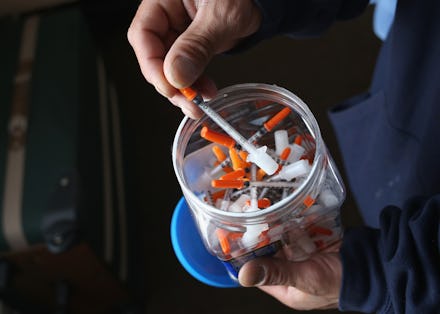An opioid 100 times more powerful than fentanyl may have caused 60 overdoses in two days

A powerful new opioid analog called carfentanil may have played a role in around 60 overdoses across Ohio and Indiana in the last two days, the Washington Post reports. Carfentanil is approximately 100 times more powerful than fentanyl — the opioid involved in Prince's death — and around 10,000 times more potent than morphine. It's occasionally used as an elephant tranquilizer.
On Tuesday, officers in Jennings County, Indiana, responded to at least 11 overdose cases, according to the Post. Starting that same day and spilling over into Wednesday, police in Hamilton County, Ohio, got more than 50 overdose calls from bathrooms, fast food restaurants, a car crash and a parking lot.
The culprit in the swath of overdoses, police believe, is heroin laced with carfentanil.
At the clinical level, health centers and hospitals don't have systems in place to handle this potent street opioid, Dr. Shawn Ryan, Chief Medical Officer at BrightView addiction treatment center in Cincinnati, Ohio, said in a phone call Thursday.
When a patient experiences a drug overdose, hospitals and clinics typically use mass spectrometry tests to find out what the patient took. But carfentanil is so new that current forms of testing don't look for it, according to Ryan.
"Coroners, or the DEA, or the FBI would test for specifics [like carfentanil]," Ryan said. "Our standard testing doesn't include things like that."
Another major problem, according to Ryan, is that Narcan, a widely used brand of the opioid overdose reversal drug Naloxone, isn't as effective when it comes to carfentanil overdoses.
"Straight carfentanil is extremely hard to revive, even with Narcan," Ryan said. "The Narcan we use to reverse heroin overdoses isn't effective."
Ryan said he needs to give patients three to five times the regular dose of Narcan when carfentanil is involved.
Unfortunately, this wave of overdoses probably isn't going away soon.
"If you show up at a hospital with a heart attack, people are called to make sure you're stable, they discharge, have a follow-up appointment and prescribe medicine — normal medical practice," Ryan said. "None of the normal pathways of care exist for what we're dealing with today. The system is not prepared to deal with it."
If the recent spate of overdoses came from carfentanil-laced heroin, cracking down on heroin street dealers might seem like the best solution. But Will Godfrey, editor-in-chief of The Influence, says people are going to use heroin no matter what — and that the safest policy is to regulate it.
"The fact that heroin is illegal and unregulated means that people who use heroin — and there will always be people who use heroin — are at the mercy of unregulated vendors," Godfrey said in a phone call. "They have no guarantee what they're buying, and that means people are at incredible unnecessary risk."
Godfrey said supervised injection facilities, places for people to use the drug with medical supervision, increased access to Narcan and prescription heroin could mean fewer fatalities from a drug diluted by street dealers.
"Switzerland successfully launched a campaign that would allow people to receive pharmaceutical heroin from a doctor," he said. "That means people know exactly what's going into their bodies. It keeps people vastly safer than heroin [bought] on the street. And it's successful in reducing fatalities."
It's an unlikely step in the U.S., where lawmakers are still grappling with marijuana legalization. But if what Ryan said is true, it will take an exceptional sea-change in strategy to deal with the current dirty heroin problem.
"Unless there's a significant change, " Ryan said, "we'll continue to have this happen for the next couple years."